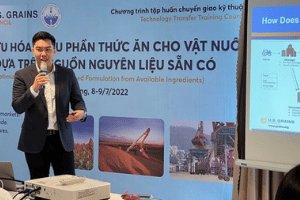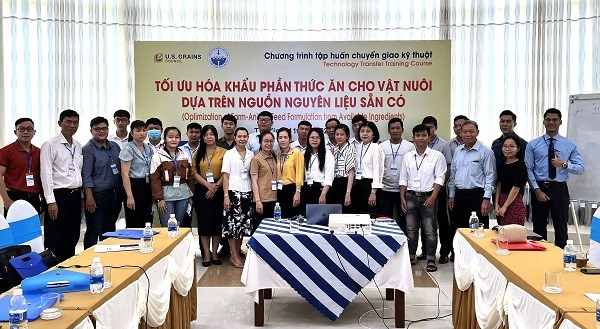Continuing its educational engagement in Vietnam, the U.S. Grains Council’s (USGC’s) Southeast Asia and Oceania (SEA&O) office partnered with the Animal Husbandry Association of Can Tho (AHA) to conduct a two-day workshop entitled Optimization of Farm Animal Feed Formulation from Available Ingredients in Vinh Long and Tra Vinh provinces, where the animal husbandry industry is large and still growing.

Limited feed optimization and price risk management knowledge is restricting the industry’s growth potential at the same time the provinces are suffering from higher raw material prices. Chuin Shern Lee, USGC regional marketing manager for SEA&O; Dr. Budi Tangendjaja, USGC regional technical consultant; and principals from AHA aimed to help participants better understand the dynamics of feed formulation, feed quality control and nutrition requirements for poultry; achieve least-cost feed rations; become familiar with feed formulation software; and get a handle on the concept of price risk management so they can be more efficient in managing their operations.
The Council reached out to participants directly involved in the animal husbandry industry, and 25 attendees, including college students majoring in agriculture or animal husbandry, lecturers, local traders, feed distributors and officials from the agriculture departments of the provinces sat in on the discussions.
“Practice makes perfect,” Tangendjaja said. “Participants should practice familiarizing themselves with the feed formulation software, utilizing feed ingredients that are more efficient and cost-reducing.”
During the price discovery training session, the software suggested distiller’s dried grains with solubles (DDGS) can be included from five to 15 percent for broiler feed depending on growth stage and can achieve overall savings in broiler production cost by 22,000 VND/kg ($0.94/kg). At the end of the training, all participants were able to formulate a complete poultry ration and determined that DDGS can be used effectively to reduce cost of poultry productions.
These results have prompted Tra Vinh University to conduct a DDGS feeding trial for colored broilers, a new breed of the native Mia chicken that is characterized by disease resistance, high uniformity and a shorter growing period in the Tra Vinh province. Colored broilers number approximately 5.5 million birds there, and the University has invited Tangendjaja to provide assistance throughout the trial.
Following a positive experience at the workshops, participants requested a follow-up training for other animal species, including swine and aqua. The Mekong River Delta is known as a large agricultural production center in Vietnam, with its aquaculture production at around 4.79 MMT and accounting for 55.7 percent of Vietnam’s total production, while pork and poultry production have also increased over the years to reach 450 KMT and 324 KMT, respectively, accounting for 10.9 and 16.9 percent of total country production.
“The Council will continue to support the growth of the animal husbandry industry in Southeast Asia by empowering the next generation with relevant knowledge and technical skills through educational programming,” Lee said.
About The U.S. Grains Council
The U.S. Grains Council develops export markets for U.S. barley, corn, sorghum and related products including distiller’s dried grains with solubles (DDGS) and ethanol. With full-time presence in 28 locations, the Council operates programs in more than 50 countries and the European Union. The Council believes exports are vital to global economic development and to U.S. agriculture’s profitability. Detailed information about the Council and its programs is online at www.grains.org.

